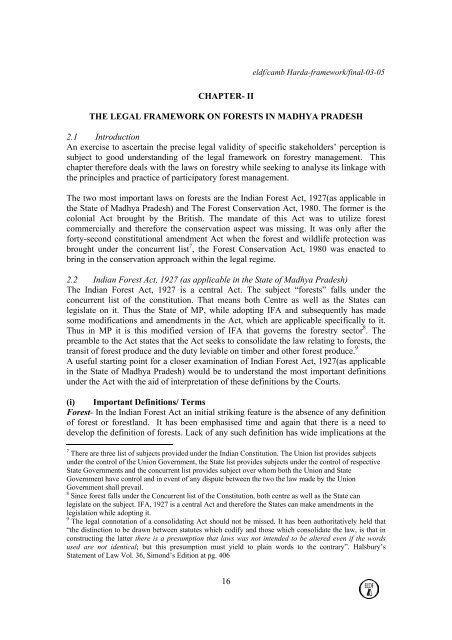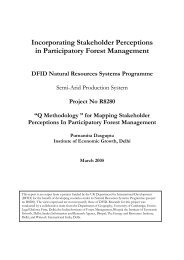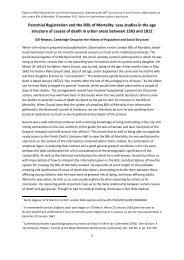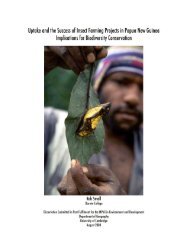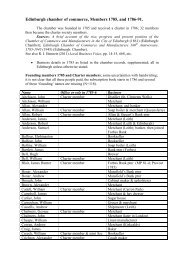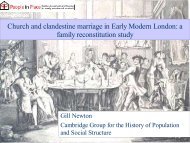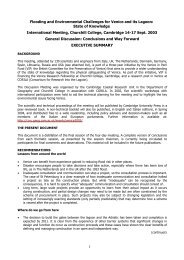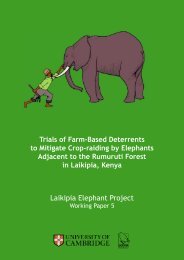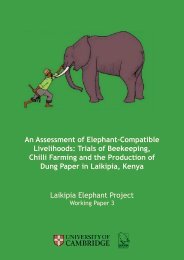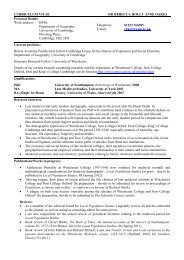Incorporating Stakeholder Perceptions in Participatory Forest
Incorporating Stakeholder Perceptions in Participatory Forest
Incorporating Stakeholder Perceptions in Participatory Forest
Create successful ePaper yourself
Turn your PDF publications into a flip-book with our unique Google optimized e-Paper software.
eldf/camb Harda-framework/f<strong>in</strong>al-03-05<br />
CHAPTER- II<br />
THE LEGAL FRAMEWORK ON FORESTS IN MADHYA PRADESH<br />
2.1 Introduction<br />
An exercise to ascerta<strong>in</strong> the precise legal validity of specific stakeholders’ perception is<br />
subject to good understand<strong>in</strong>g of the legal framework on forestry management. This<br />
chapter therefore deals with the laws on forestry while seek<strong>in</strong>g to analyse its l<strong>in</strong>kage with<br />
the pr<strong>in</strong>ciples and practice of participatory forest management.<br />
The two most important laws on forests are the Indian <strong>Forest</strong> Act, 1927(as applicable <strong>in</strong><br />
the State of Madhya Pradesh) and The <strong>Forest</strong> Conservation Act, 1980. The former is the<br />
colonial Act brought by the British. The mandate of this Act was to utilize forest<br />
commercially and therefore the conservation aspect was miss<strong>in</strong>g. It was only after the<br />
forty-second constitutional amendment Act when the forest and wildlife protection was<br />
brought under the concurrent list 7 , the <strong>Forest</strong> Conservation Act, 1980 was enacted to<br />
br<strong>in</strong>g <strong>in</strong> the conservation approach with<strong>in</strong> the legal regime.<br />
2.2 Indian <strong>Forest</strong> Act, 1927 (as applicable <strong>in</strong> the State of Madhya Pradesh)<br />
The Indian <strong>Forest</strong> Act, 1927 is a central Act. The subject “forests” falls under the<br />
concurrent list of the constitution. That means both Centre as well as the States can<br />
legislate on it. Thus the State of MP, while adopt<strong>in</strong>g IFA and subsequently has made<br />
some modifications and amendments <strong>in</strong> the Act, which are applicable specifically to it.<br />
Thus <strong>in</strong> MP it is this modified version of IFA that governs the forestry sector 8 . The<br />
preamble to the Act states that the Act seeks to consolidate the law relat<strong>in</strong>g to forests, the<br />
transit of forest produce and the duty leviable on timber and other forest produce. 9<br />
A useful start<strong>in</strong>g po<strong>in</strong>t for a closer exam<strong>in</strong>ation of Indian <strong>Forest</strong> Act, 1927(as applicable<br />
<strong>in</strong> the State of Madhya Pradesh) would be to understand the most important def<strong>in</strong>itions<br />
under the Act with the aid of <strong>in</strong>terpretation of these def<strong>in</strong>itions by the Courts.<br />
(i) Important Def<strong>in</strong>itions/ Terms<br />
<strong>Forest</strong>- In the Indian <strong>Forest</strong> Act an <strong>in</strong>itial strik<strong>in</strong>g feature is the absence of any def<strong>in</strong>ition<br />
of forest or forestland. It has been emphasised time and aga<strong>in</strong> that there is a need to<br />
develop the def<strong>in</strong>ition of forests. Lack of any such def<strong>in</strong>ition has wide implications at the<br />
7 There are three list of subjects provided under the Indian Constitution. The Union list provides subjects<br />
under the control of the Union Government, the State list provides subjects under the control of respective<br />
State Governments and the concurrent list provides subject over whom both the Union and State<br />
Government have control and <strong>in</strong> event of any dispute between the two the law made by the Union<br />
Government shall prevail.<br />
8 S<strong>in</strong>ce forest falls under the Concurrent list of the Constitution, both centre as well as the State can<br />
legislate on the subject. IFA, 1927 is a central Act and therefore the States can make amendments <strong>in</strong> the<br />
legislation while adopt<strong>in</strong>g it.<br />
9 The legal connotation of a consolidat<strong>in</strong>g Act should not be missed. It has been authoritatively held that<br />
“the dist<strong>in</strong>ction to be drawn between statutes which codify and those which consolidate the law, is that <strong>in</strong><br />
construct<strong>in</strong>g the latter there is a presumption that laws was not <strong>in</strong>tended to be altered even if the words<br />
used are not identical; but this presumption must yield to pla<strong>in</strong> words to the contrary”. Halsbury’s<br />
Statement of Law Vol. 36, Simond’s Edition at pg. 406<br />
16


